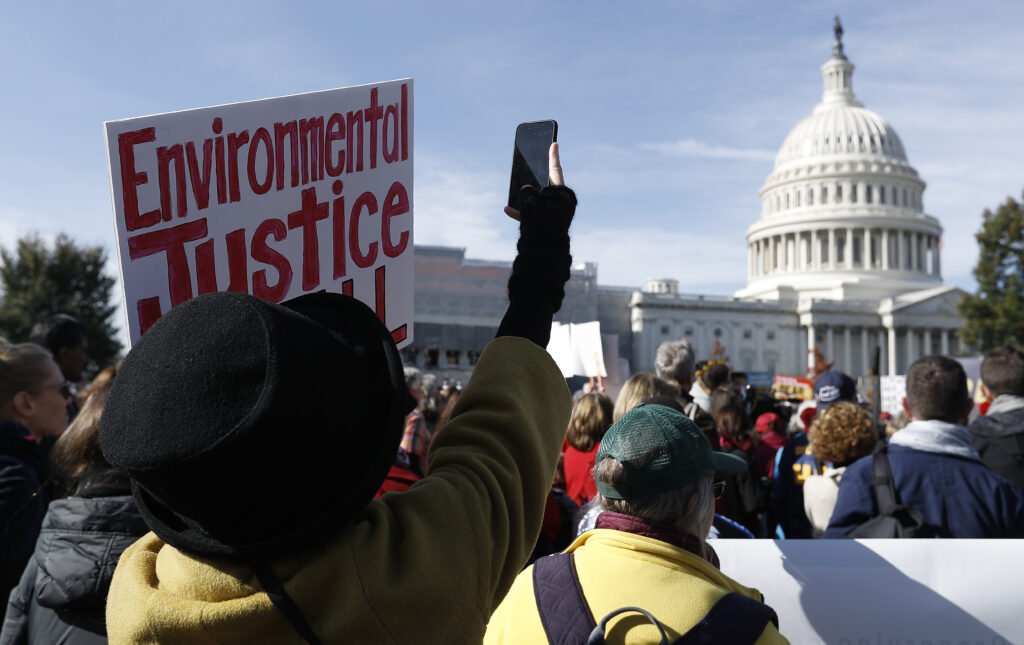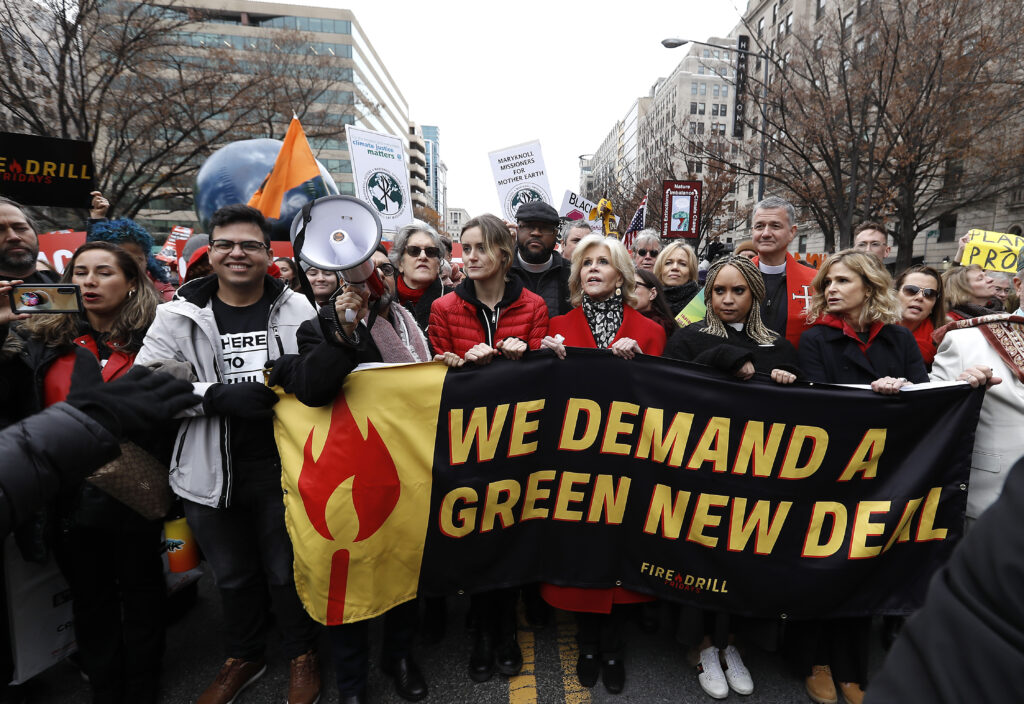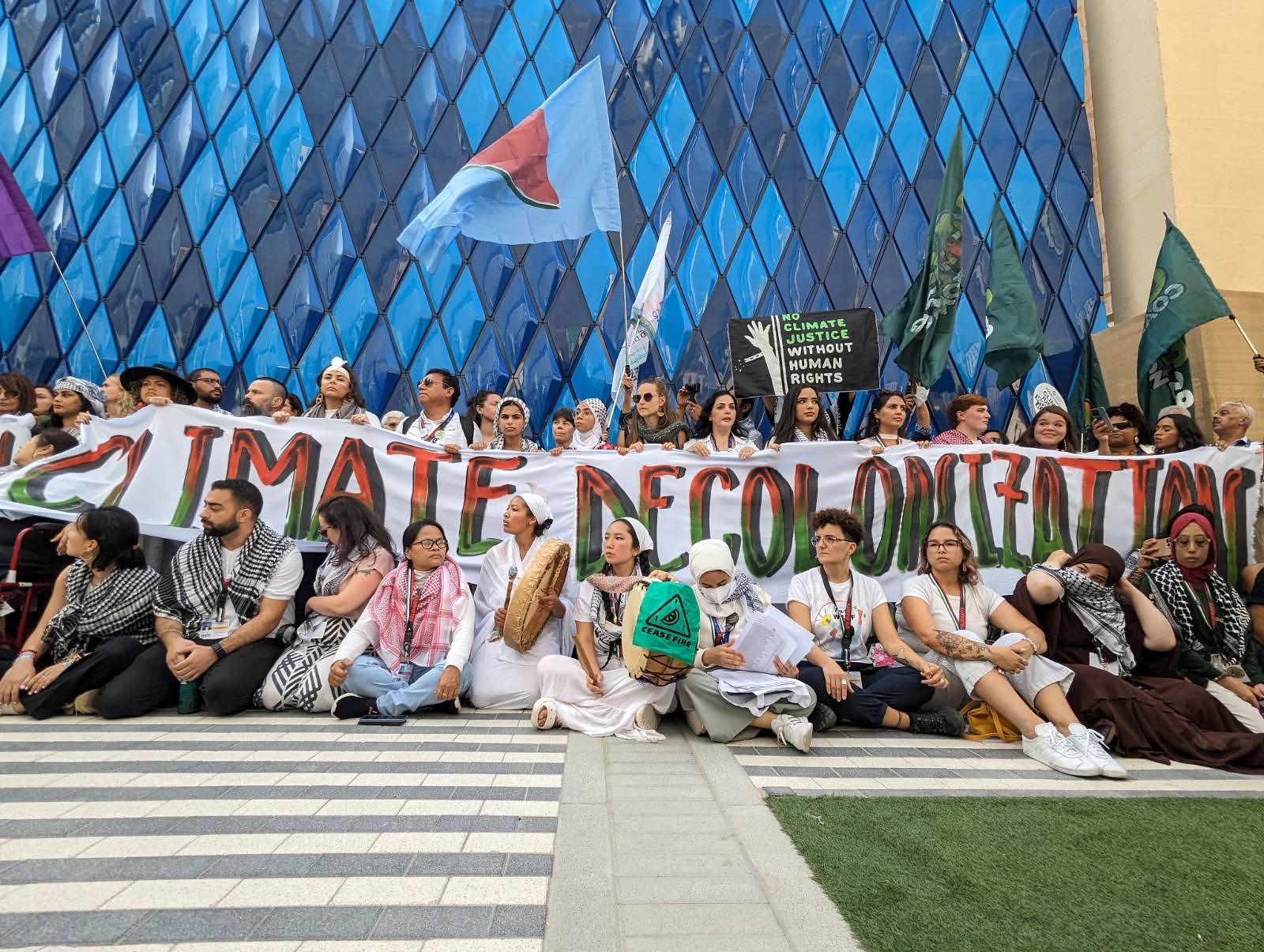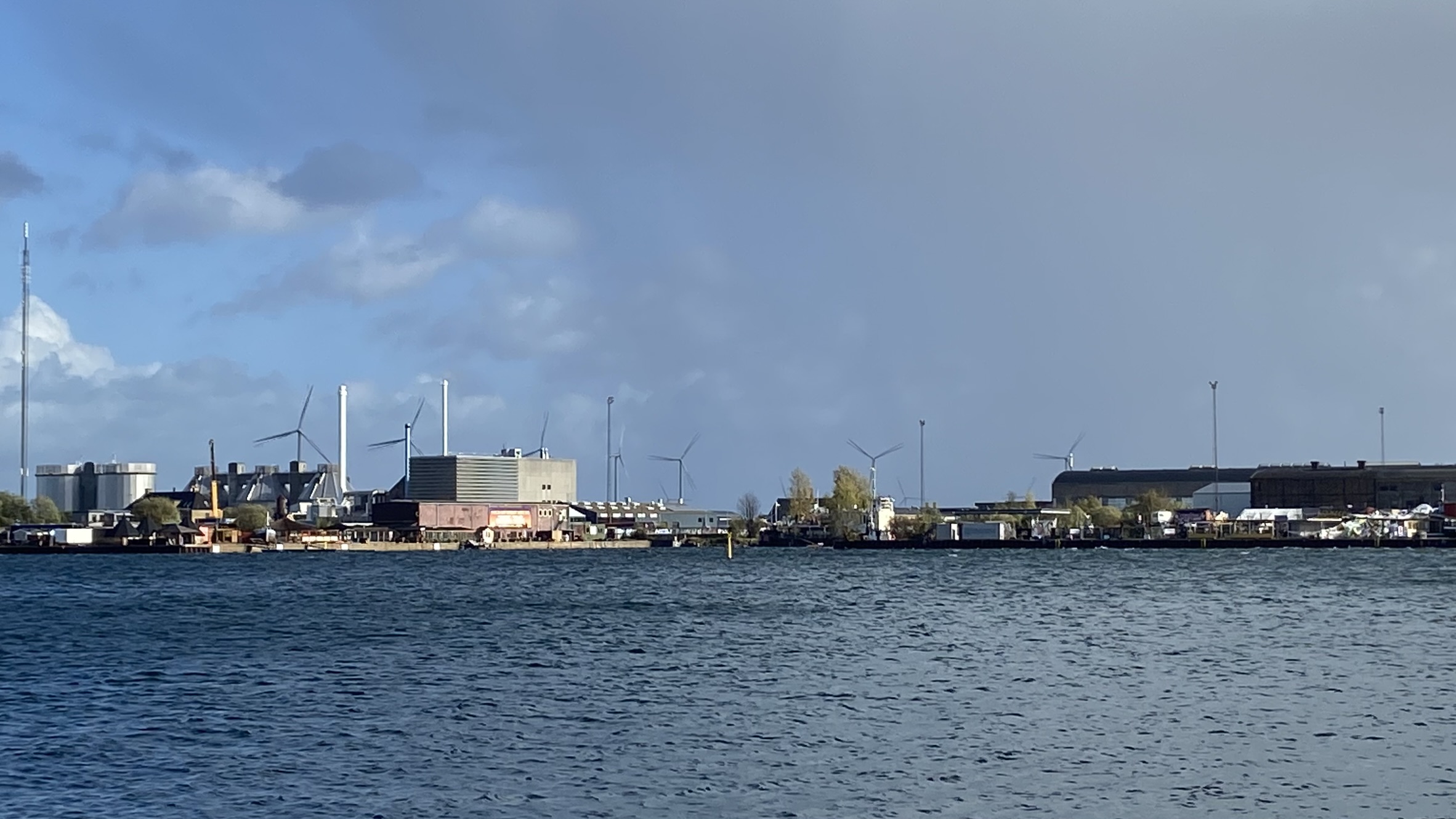This article is part of our series “On the Precipice: A Progressive Agenda in the Biden Era.” Download a PDF of the full series here.
Ecological Justice or Death
At the end of the 2020 U.S. Presidential election season, Joe Biden released a series of ads showcasing stories of ordinary Americans confronting climate chaos — of oyster fisherfolk in the Florida Keys whose catches are at risk from ocean acidification, of a beekeeper in Arizona whose bee colonies are being threatened by extreme heat, and of an entrepreneur building a solar business in Navajo country. In one clip that aired nationally, the campaign juxtaposed shots of relentless wildfires and Melanie, a wildland firefighter from Phoenix, Arizona, saying, “People are continuing to die. You keep fighting a battle that doesn’t end.” She was right.
With this series of advertisements, along with a steady drumbeat of climate policy promises, Joe Biden made climate action a closing bid of his race. He doubled down on the fact that a majority of Americans want to see the government act on climate. And he won.
This past year was not only marked by a pandemic but also by relentless climate chaos. Skies over parts of the western U.S. turned a deep orange from the smoke of wildfires. Torrential rains and floods inundated Southeast Asia, East Africa, and the American Midwest. Hurricane after hurricane barraged the Gulf South and the Caribbean during a historic storm season. All of this occurred as COVID-19 gripped and decimated the world.
The pandemic cast a spotlight on the deep structural inequalities of society. In the U.S., Black, Indigenous, and people of color populations faced higher infection and mortality rates from COVID-19. Evidence now shows that exposure to pollution increases risk to the disease all over the world. As the economy has collapsed, it is mostly Black and brown essential workers and women in the service sectors who have kept society functioning while continually putting themselves at risk. This year, the world witnessed the brutal force of emergency upon emergency aggravate centuries of racial violence and economic impoverishment.

However, there is a vision for rebuilding our economy and mobilizing every arm of government to address both the acute economic crisis caused by this pandemic and the long-term crises of climate emergency and inequality. This plan has many names — a green recovery, a green stimulus, a just recovery, or simply a Green New Deal. By whatever name, the idea is tantalizing: industrial-scale investments in the economy to expand livelihoods for people while transitioning to a low-carbon future. These economic investments, coupled with social investments, such as in housing and healthcare, build resilience to future disasters, even as we emerge out of this one. This vision is the beginning of a just response to climate chaos.
In his Presidential campaign, Biden championed elements of a Green New Deal in all but name, a result of pressure from climate advocates, led by young people and people of color who demanded political leadership confront climate reality. Now that the Senate is under Democratic control, climate justice activists retain a chance at winning significant climate legislation, potentially even the beginnings of a Green New Deal. But this is not guaranteed.
As Biden is inaugurated and a brand new Congress begins session, the climate justice left–the coalition of forces across environmental, social justice, and political movement sectors–will face the continued urgency of an inequitable climate crisis along with the reticence of neoliberal plutocrats who will insist on incrementalism.
The defeat of the climate-denier-in-chief has opened up a chance–slim as it may be–of survival against climate chaos. Biden’s first months will determine just what the odds are. Movements can leverage even small concrete victories in this critical window to widen the possibility for wholescale economic and political transformation. For many communities failure in the next few years is not an option. In the words of Rosa Luxemburg, the world is at the crossroads of socialism or barbarism. And in the case of the climate crisis, it is ecological justice or death.
The Specter of the Green New Deal
Through crisis, a vision of an irresistible future has haunted American and global politics: the specter of a Green New Deal. Through the efforts of young people, environmental justice leaders, grassroots organizations led by people of color, and a climate justice movement that increasingly moves in formation toward what may be called a climate justice united front, the Green New Deal has become a galvanizing vision and a litmus test for progressive political leadership. Grassroots organizing pushed and shifted the political landscape from a place where Democrats had no clear plans to address climate change, to climate policy standing at the core of a new governing agenda.
Despite conservatives lambasting the Green New Deal, voters are motivated by, and still demand, bold climate action from political leaders. The idea that climate solutions can and must address intertwined economic and racial inequality has expanded the scope of possibility for climate policy to not just address emissions but to also be economically transformative, redistributive, and reparative.
Where beltway climate policy had been prescribed around carbon emissions reductions–a strategy that consistently failed–the Green New Deal binds together climate solutions, investments to create good jobs, and justice. This logic is rooted in the lived reality that every aspect of society is affected by a climate crisis intertwined with white supremacy, colonialism, and economic inequity. Thus solutions must be as concerned with restoring an equitable economy, achieving racial justice, and building social infrastructure as they are with the molecules of greenhouse gases in the atmosphere.
While some climate hawks initially balked at attaching various social policies like affordable housing development or investments in healthcare to climate policies, this was the strength of the Green New Deal vision. Its expansiveness is what has made the idea irresistible. New political alignments have formed–for example, the Green New Deal Network, which launched this month, is a coalition that includes groups like Sunrise Movement, Climate Justice Alliance, Indigenous Environmental Network, political organizations like Indivisible, People’s Action, Working Families, traditional environmental groups like Sierra Club and Greenpeace, and labor unions like SEIU International. The Green New Deal has gone global, influencing a vision for a climate-forward Europe. And efforts to outline a global Green New Deal are underway.
The original New Deal was a response not only to the Great Depression but decades of militant worker organizing. The years preceding the original New Deal saw millions of workers engage in massive strikes, including three city-wide general strikes in 1934 in Minneapolis, San Francisco, and Toledo, and historic sit-down strikes in Flint, Michigan in 1936 and 1937, opening a wave of further strikes across the country. Today we face a similar economic collapse and spiraling inequality, just as our social movements are activating people across the country for climate justice and in defense of Black Lives.
Movements today don’t yet have the same scale that militant social movements had at the turn of the last century, but this century’s movements for justice are building strength. In September 2019, millions participated in youth climate strikes in the U.S. And in the summer of 2020 Black Lives Matter protests swept the country, and then the world. Deep grassroots organizing in communities of color delivered the critical electoral victories of 2020. And the coalitions winning just and equitable climate solutions are broad coalitions aligned on climate, a vibrant economy, and justice. A key lesson from the original New Deal is that transformative solutions won’t happen by accident. They arise in response to massive action.
This year, massive climate action is more tangible than ever, just as the scientific window for climate action narrows. President Biden’s administration will face scrutiny and pressure to fulfill his promises to address the climate crisis. A Democratic trifecta in government means movements could pressure Congress to pass remarkable legislation. In this period, the climate justice left can create points of leverage, continue to contest for and wield power, and win victories that will have generational consequences. By leveraging even small policy wins, we may blow open the bounds of the politically possible toward the materially necessary. Climate justice advocates, coalitions, and organizers must leap at every chance to win in ways that further our movement’s infrastructure and power.
The climate policies we can win at this juncture will not be the full extent of a Green New Deal. Even a Green New Deal will not be enough to achieve our economy’s transformation away from extractive, white supremacist, and colonial hegemony. Climate activists and policy wonks have generally united on climate and energy solutions’ centrality to a Green New Deal’s vision. However, the Green New Deal’s transformative potential goes beyond climate and energy. A just and equitable transformation of our economy is about ensuring a good life for everyone, it is about expanding the social safety net, and it is about restoring our relationships with our environment.
As climate policy fights devolve into technocratic arguments around the minutiae of energy policy, let us cast a light on unattended spaces that also hold the potential for wins that could build political power. There lie possibilities to expand the Green New Deal’s scope towards achieving ecological justice.
The Road to Victory
Momentum is on the side of the climate justice movement. The political organizing of climate activists has produced, for example, the powerful narrative that Joe Biden has the mandate to implement climate solutions. In the year preceding the COVID-19 pandemic, the world witnessed millions of people take the streets to demand climate action. This was the latest manifestation of decades of environmental action. If Biden makes Rooseveltian moves, it will not be of his sole volition, but because of the movements that push him. Coalitions like NY Renews in New York, the Gulf South for a Green New Deal, and the national Green New Deal Network are building a united front around a vision for a Green New Deal that could leverage significant political power from the local to the national level. The environmental justice movement now has unprecedented access to the White House and the ear of allies in Congress due to years of organizing.

While our movements will not win everything we want in 2021, we can leverage climate policy battles to fortify movement infrastructure and win bolder in the next fights. Georgia didn’t turn blue overnight. Black women leaders built out an ecosystem that activated Black voters over years, eventually winning a political shift that may have saved us all from climate catastrophe. Building power means being able to contend for political power and developing political projects that articulate a vision for ecological justice. This year, and the years ahead, we must accelerate our organizing, be deliberate, aggressive, and even ruthless in seizing political opportunities, and invest in movement infrastructure at every step of the way.
Second, the incoming administration appears truly receptive to progressive climate policy. However, if the pattern of history holds, whatever the Biden administration will propose to address the climate crisis will not be enough. While bold, Biden’s climate platform does not represent the full breadth of what is possible in a Green New Deal. Even with a Democratic Congress, he will not achieve most of what he has promised in his first year due to conservatives, centrists, and corporate forces who will hamstring progressive ideas along the way. However, this administration is the only chance we have to advance Federal climate policy in the near term.
Policy experts have consistently held up investments and standards as pathways to a renewable energy transition, and Biden’s climate plans confer this. We have allies in Congress ready to introduce bold bills on electric vehicles, energy policy, and large-scale investment in renewables. To expand the scope of what is possible in this administration, we must fight for, win, and leverage what a Biden administration demonstrates receptivity towards. But we also must attach to the coattails of climate and energy policy, the rest of what makes a Green New Deal truly transformative, like land and agricultural policies, investments in the healthcare sector, and reparative and redistributive justice social policy. It is up to movements to attach transformative elements to the specter of the Green New Deal, so everyone knows exactly what we mean and what we demand to win.
Third, confrontations at the frontlines of fossil fuel extraction and climate disaster are producing untenable conflict. Battles such as those over pipelines like Keystone XL, the Dakota Access Pipeline, and Line 3 in Minnesota, led by Indigenous peoples on the ground, will escalate just as the Indigenous movement has won a critical ally in Deb Haaland in the administration. The pressure to stop fossil fuel extraction has been consistent over decades, resulting in large financial institutions around the globe divesting funds from the sector. Biden himself publicly committed to end fossil fuel leasing on public lands and end oil and gas subsidies. The channeling of the militant resistance at the frontlines of the climate crisis towards the Biden administration could accelerate a wind-down of fossil fuel production. The dismantling of fossil fuel hegemony via policies like ending extraction infrastructure and subsidies to the industry must be part of a comprehensive climate agenda.
Finally, such victories could provide unrecoverable blows to an industry already facing collapse: Fossil fuel industry is facing volatile drops in oil and gas prices, the divestment movement’s success at degrading the sector’s moral authority, and the impacts of acute economic collapse resulting in widespread bankruptcy and oil majors laying off tens of thousands of workers. These are cracks in fossil fuel hegemony that the climate justice left must be ruthless in taking advantage of while taking care to support a just transition for fossil fuel workers affected by an already unstable sector.
The crises of this moment, caused in significant part by ecological disruption perpetrated by fossil capital, are now at the same time producing the opening for concrete victories that could be politically and economically transformative. The work at hand is to leverage the portals of this moment, win material victories, and shift the center of climate solutions ever closer toward ecological justice.
Free the Land
For example, land and agriculture policy are arms of a Green New Deal that hold enormous potential for victory from the margins to the center. They are, in fact, critical to building power to win a Green New Deal. The climate justice left could build a coalition with food justice movements, small farmers and rural communities, Indigenous activists, and those fighting to protect ecosystems. Victory could look like land, agriculture, and conservation policy that is reparative to the historic displacement of Black and Indigenous communities and regenerative to the ecosystems that the state and corporations have destroyed.
An emboldened Secretary of the Interior in Deb Haaland could usher a historic wave of land management policy that invests in and protects public lands and respects Indigenous sovereignty. Her appointment to the Department of Interior could create a window for some of the most justice-oriented Green New Deal solutions to advance. Strengthening respect for indigenous sovereignty and engagement with Tribes regarding lands–an element included in the original Green New Deal resolution in Congress–would be a significant pivot from the settler land policies of the United States.
A radical reinvestment in public lands can transform the wider public’s relationship to public goods and governance–we could fully fund the National Parks, and we could also demand a reinstatement of a Civilian Conservation Corps to support Black and brown young people’s employment in STEM fields and conservation. Under Deb Haaland, the Interior could play a role in advancing “land back”–restoring lands to Native tribes and communities–via Tribal lands management arrangements, support for traditional conservation practices, and rematriation of lands to tribes.
The Justice for Black Farmers Act shows what is possible with reparative and regenerative agricultural policy. Introduced at the end of 2020, the law aims to facilitate the transfer of millions of acres of working lands back to Black farmers. Black farmers have lost over 90% of their land base in the last century due to the racist policies of agencies like the USDA. Getting these laws passed and implemented can pave the way for climate solutions that start to appear like models for reconciliation and reparations.
While opportunities like these arise, the climate justice left will also contend with the strictures of a neoliberal administration. Even under a Democratic trifecta, progressives will have to battle against centrist Democrats beholden to fossil fuel money. Simultaneously, as climate and Indigenous leaders have lauded Haaland’s appointment, food and farm activists have derided Tom Vilsack’s re-appointment to the post of Secretary of Agriculture. Vilsack is a friend of big agriculture, and under his former leadership, the USDA perpetrated some of its most egregious and racist policies. Will he pivot in response to the times and invest in Black, brown, and small farmer communities, or will he repeat his past mistakes? Activists and advocates must change the political conditions, so leaders have no choice but to pivot towards the road to a Green New Deal. We must be relentless in our pursuit of victory, leveraging every chance to expand what is politically possible.
“What can we do today, so that tomorrow we can do what we are unable to do today?” – Paolo Freire
At the dawn of 2021, climate justice and racial justice movements pose what may be the most revolutionary confrontations of our time. Movement organizations and coalitions are building political power–as victories in Georgia demonstrated. Against the centrist and neoliberal forces that will attempt to pivot the nation back to business-as-usual, our movements must secure every opening to advance the power of organized people and limit the power of organized capital. Democrats will not do what is necessary on their own. We must organize.
The fight to win climate investments and emissions targets are simply the tip of the spear of a Green New Deal. We must also leverage unforeseen openings–like those for redistributive land policy through an emboldened Department of Interior. At this moment, we may have a greater upper hand than we have ever had in our lifetimes. A modest group of young people sitting in Nancy Pelosi’s office in 2018 threw the Green New Deal into the national spotlight, ultimately transforming the political promises of Presidential candidates and the now-President. Today we have stronger climate justice movement coalitions and organizing infrastructure aligned on a vision of climate justice.
We have a chance to advance solutions that will build organizing power, and we must take it. Even if the Biden administration fails on its boldest promises, our work is to leverage near-term fights to seed openings for irresistible political victory in the next battle. No piece of the ecological justice agenda is too small to organize and build power through.
In 2018 the Green New Deal was a wonky idea that no one had heard of. Today it is an idea whose time has come. The specter of the Green New Deal haunts conservatives and neoliberal centrists alike. It may be the most powerful tool we have at our disposal for standing up against climate chaos. But like the idea of a New Deal that preceded it in a previous time of global crisis, alone, it is just a vision. It is up to movements to demand and win the full scope of what we need. This year we will lay the groundwork for what will be possible for the next four years and the generation to come. We can not let any opening to expand the popularity and scope of our vision for a better world slip by.
Can we imagine and operate as if this year and a Biden Presidency were a portal to the next world? We must organize, fortify movement infrastructure, test-balloon progressive and bold eco-socialist ideas, and begin to dismantle the power of our enemies. We may be in the Decade of a Green New Deal, but it will not arrive by accident. The Green New Deal is an opening. It is only the beginning of what we need. We must be ruthless in wrestling every victory because with this presidency, we have just barely retained a chance at survival.
Adrien Salazar is a climate justice advocate and campaign strategist who has been organizing for climate policy solutions, food justice, and environmental justice for over a decade. Formerly with Demos, Adrien helped pass New York’s landmark 2019 climate legislation with the New York Renews coalition. He sits on the board of the Sustainable Economies Law Center and the Filipino American Coalition for Environmental Solidarity, is a Senior Fellow with Data for Progress, and is fighting to win a Green New Deal in the U.S.



